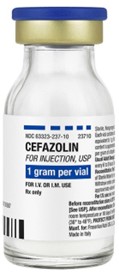A nurse is caring for an adolescent who has an allergy to penicillin. Which of the following prescriptions should the nurse clarify with the provider?
Doxycycline
b) Vibranycin
Cefazolin
Gentamicin
The Correct Answer is C
The nurse should clarify the prescription for cefazolin with the provider. Cefazolin is a cephalosporin antibiotic, and there is a risk of cross-reactivity in individuals who have an allergy to penicillin.
a) Doxycycline and b) Vibramycin (which is another name for doxycycline) are tetracycline antibiotics and are not related to penicillin.
d) Gentamicin is an aminoglycoside antibiotic and is also not related to penicillin.

Nursing Test Bank
Naxlex Comprehensive Predictor Exams
Related Questions
Correct Answer is C
Explanation
A nurse reviewing the laboratory results of a client who has DKA should identify that the client's ABG results of pH 7.30, PaCO₂ 34 mm Hg and HCO₃ 21 mEq/L indicate metabolic acidosis. Metabolic acidosis is an acid-base imbalance characterized by a low pH (less than 7.35) and a low bicarbonate level (less than 22 mEq/L).
The other options are not correct.
a) Respiratory alkalosisis an acid-base imbalance characterized by a high pH (greater than 7.45) and a low PaCO₂ (less than 35 mm Hg).
b) Metabolic alkalosisis an acid-base imbalance characterized by a high pH (greater than 7.45) and a high bicarbonate level (greater than 26 mEq/L).
d) Respiratory acidosisis an acid-base imbalance characterized by a low pH (less than 7.35) and a high PaCO₂ (greater than 45 mm Hg).
Correct Answer is B
Explanation
A nurse collecting data for a client following electroconvulsive therapy should expect that the client may experience confusion as an adverse effect. Confusion is a common side effect of electroconvulsive therapy and can last for minutes to hours after treatment.
The other options are not typical adverse effects of electroconvulsive therapy.
a) Vomitingis not a typical adverse effect of electroconvulsive therapy.
c) Incontinenceis not a typical adverse effect of electroconvulsive therapy.
d) Tinnitusis not a typical adverse effect of electroconvulsive therapy.

Whether you are a student looking to ace your exams or a practicing nurse seeking to enhance your expertise , our nursing education contents will empower you with the confidence and competence to make a difference in the lives of patients and become a respected leader in the healthcare field.
Visit Naxlex, invest in your future and unlock endless possibilities with our unparalleled nursing education contents today
Report Wrong Answer on the Current Question
Do you disagree with the answer? If yes, what is your expected answer? Explain.
Kindly be descriptive with the issue you are facing.
